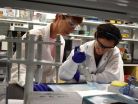(Press-News.org) Screening mammography was associated with increased diagnosis of small cancers in a study across U.S. counties but not with significant changes in breast cancer deaths or a decreased incidence of larger breast cancers, which researchers suggest may be the result of overdiagnosis, according to an article published online by JAMA Internal Medicine.
The goal of screening mammography is to reduce breast cancer death by detecting and treating cancer early in the course of the disease. If screening detects tumors early, the diagnosis of smaller and more treatable cancers should increase, while the diagnosis of larger and less treatable cancers should decrease. However, there are increasing concerns that screening unintentionally leads to overdiagnosis by identifying small, indolent or regressive tumors that would not otherwise become clinically apparent.
Richard Wilson, D.Phil., of Harvard University, Cambridge, Mass., and coauthors conducted an ecological study of 16 million women ages 40 and older who lived in 547 counties reporting to Surveillance, Epidemiology and End Results cancer registries during the year 2000. Of these women, 53,207 were diagnosed with breast cancer that year and followed up for the next 10 years.
The authors examined the extent of screening in each county and measured breast cancer incidence in 2000 and incidence-based breast cancer death during the 10-year follow-up, with incidence and mortality calculated for each county.
The authors found that across counties there was a correlation between the extent of screening and breast cancer incidence but not with breast cancer mortality. An increase of 10 percentage points in the extent of screening was associated with 16 percent more breast cancer diagnoses but not significant change in breast cancer deaths.
More screening also was associated with increased incidence of small breast cancers of 2 centimeters or less but not with a decreased incidence of larger breast cancers, according to the results. An increase of 10 percentage points in screening was associated with a 25 percent increase in the incidence of small breast cancers and a 7 percent increase in the incidence of larger breast cancers.
"Across U.S. counties, the data show that the extent of screening mammography is indeed associated with an increased incidence of small cancers but not with decreased incidence of larger cancers or significant differences in mortality. ... What explains the observed data? The simplest explanation is widespread overdiagnosis, which increases the incidence of small cancers without changing mortality, and therefore matches every feature of the observed data," the authors conclude.
However, the authors note clinicians are correct to be wary of ecological studies because of ecological fallacy, which is making inferences about individuals from group data in statistical analyses because individuals may not possess those characteristics.
"As is the case with screening in general, the balance of benefits and harms is likely to be most favorable when screening is directed to those at high risk, provided neither too frequently nor too rarely, and sometimes followed by watchful waiting instead of immediate active treatment," the study concludes.
(JAMA Intern Med. Published online July 6, 2015. doi:10.1001/jamainternmed.2015.3043. Available pre-embargo to the media at http://media.jamanetwork.com.)
Editor's Note: Authors made conflict of interest disclosures. Please see the article for additional information, including other authors, author contributions and affiliations, financial disclosures, funding and support, etc.
Commentary: Effect of Screening Mammography on Cancer Incidence, Mortality
In a related commentary, Joann G. Elmore, M.D., M.P.H., of the University of Washington, Seattle, and Ruth Etzioni, Ph.D., of the Fred Hutchinson Cancer Research Center, Seattle, write: "However, much has also been written about the caution needed when interpreting ecological analyses. It is well known, for example, that ecological studies provide no information as to whether the people who were actually exposed to the intervention were the same people who developed the disease, whether the exposure or the onset of disease came first, or whether there are other explanations for the observed association."
"We need clear communication and better tools to help women make informed decisions regarding breast cancer screening mammography. ... Perhaps most important, we need to learn how to communicate with our patients about uncertainty and the limits of our scientific knowledge. In the end, we all need to become comfortable with informing women that we do not know the actual magnitude of overdiagnosis with precision. Part of informed decision making is providing all the information, even our uncertainty," the authors conclude."
(JAMA Intern Med. Published online July 6, 2015. doi:10.1001/jamainternmed.2015.3056. Available pre-embargo to the media at http://media.jamanetwork.com.)
Editor's Note: An author made a conflict of interest disclosure. Please see the article for additional information, including other authors, author contributions and affiliations, financial disclosures, funding and support, etc.
INFORMATION:
Media Advisory: To contact corresponding author Richard Wilson, D.Phil., call Peter Reuell at 617-496-8070 or email preuell@fas.harvard.edu. To contact corresponding commentary author Joann G. Elmore, M.D., M.P.H., call Leila R. Gray at 206-685-0381 or email leilag@uw.edu. An audio interview with the authors will be available when the embargo lifts on the JAMA Internal Medicine website.
To place an electronic embedded link in your story: Links will be live at the embargo time: http://archinte.jamanetwork.com/article.aspx?doi=10.1001/jamainternmed.2015.3043 and http://archinte.jamanetwork.com/article.aspx?doi=10.1001/jamainternmed.2015.3056
Related content: A Viewpoint article entitled "The Divide Between Breast Density Notification Laws and Evidence-Based Guidelines for Breast Cancer Screening, Legislating Practice" by corresponding author Jennifer S. Haas, M.D., M.Sc., of Brigham and Women's Hospital, Boston, also is being published. Please visit the For The Media website to access the full article.
Many physicians and advanced practice clinicians, including registered nurse practitioners, midwives and physician assistants, reported to work while being sick despite recognizing this could put patients at risk, according to the results of a small survey published online by JAMA Pediatrics.
Health-care associated infections can lead to substantial illness and death and excess costs. This is especially true for immunocompromised patients and others at high risk, including neonates. However, a gap in knowledge exists about the reasons why attending physicians and advanced ...
A small fraction of pregnancies occur in women with epilepsy but a new study suggests those women may be at higher risk for complications and death during delivery, according to an article published online by JAMA Neurology.
Between 0.3 percent and 0.5 percent of all pregnancies occur in women with epilepsy. However, there is inadequate data on obstetrical outcomes so the risk of adverse outcomes and death in this population of women remains largely unquantified.
Sarah C. MacDonald, B.Sc., of the Harvard T.H. Chan School of Public Health, Boston, and coauthors looked ...
Cognitive behavioral therapy is a widely used nonpharmacologic treatment for insomnia disorders and an analysis of the medical literature suggests it also can work for patients whose insomnia is coupled with psychiatric and medical conditions, according to an article published online by JAMA Internal Medicine.
Previous meta-analyses have suggested that cognitive behavioral therapy for insomnia can improve sleep, although many of these studies excluded individuals with co-existing psychiatric and medical conditions.
Jason C. Ong, Ph.D., of Rush University Medical Center, ...
MADISON - The newfound ability of a protein of the intestines and lungs to distinguish between human cells and the cells of bacterial invaders could underpin new strategies to fight infections.
Writing this week (July 6, 2015) in the journal Nature Structural and Molecular Biology, a team led by University of Wisconsin-Madison Professor Laura Kiessling describes the knack of a human protein known as intelectin to distinguish between our cells and those of the disease-causing microbes that invade our bodies.
"This has the potential to change the game in terms of how ...
Studying brain scans and cerebrospinal fluid of healthy adults, scientists have shown that changes in key biomarkers of Alzheimer's disease during midlife may help identify those who will develop dementia years later, according to new research.
The study, at Washington University School of Medicine in St. Louis, is published July 6 in JAMA Neurology.
"It's too early to use these biomarkers to definitively predict whether individual patients will develop Alzheimer's disease, but we're working toward that goal," said senior author Anne Fagan, PhD, a professor of neurology. ...
A blood-borne molecule that increases in abundance as we age blocks regeneration of brain cells and promotes cognitive decline, suggests a new study by researchers at UC San Francisco and Stanford School of Medicine.
The molecule in question, known as beta-2 microglobulin, or B2M, is a component of a larger molecule called MHC I (major histocompatibility complex class I), which plays a major role in the adaptive immune system. A growing body of research indicates that the B2M-MHC I complex, which is present in all cells in the body except red blood cells and plasma cells, ...
What gives plastic objects their flexibility and reduces their brittleness is the concentration of plasticiser. For example, a chemical solvent of the phthalate family called DOP is often used. The trouble is there are concerns that phthalates present health risks. So there is a demand for more alternatives. Now, scientists from China have examined the effect of using DEHHP, a new eco-friendly plasticiser, used in combination with PVC. For a plasticiser to work, there has to be adequate hydrogen bonding with the plastic. By combining experiments and simulations, the team ...
Nearly 800 million people worldwide don't have access to safe drinking water, and some 2.5 billion people live in precariously unsanitary conditions, according to the Centers for Disease Control and Prevention. Together, unsafe drinking water and the inadequate supply of water for hygiene purposes contribute to almost 90% of all deaths from diarrheal diseases -- and effective water sanitation interventions are still challenging scientists and engineers.
A new study published in Nature Nanotechnology proposes a novel nanotechnology-based strategy to improve water filtration. ...
Optogenetics techniques, which allow scientists to map and control nerve cells using light stimulation, are being used to study neural circuits in the brain with unprecedented precision. This revolutionary technology relies on light-sensitive proteins such as channelrhodopsins, and researchers at UC Santa Cruz have now determined the molecular mechanism involved in the light-induced activation of one of these proteins.
The new findings, published July 3 in two papers in the Journal of Biological Chemistry, can help scientists create tailor-made proteins optimized for ...
Evolutionary change in a gene resurrected in the lab from the extinct woolly mammoth altered the gene's temperature sensitivity and likely was part of a suite of adaptations that allowed the mammoth to survive in harsh arctic environments, according to new research. In a study published in Cell Reports on July 2, 2015, researchers determined the whole-genome sequence of two woolly mammoths and three modern Asian elephants, predicted the function of genetic changes found only in the mammoths, and then experimentally validated the function of a woolly mammoth gene reconstructed ...

